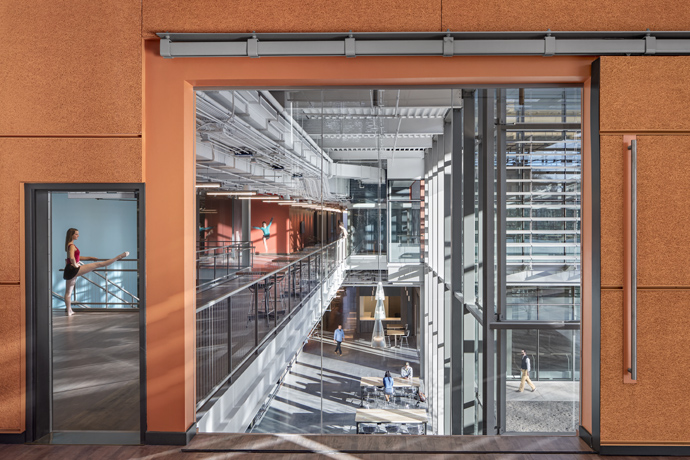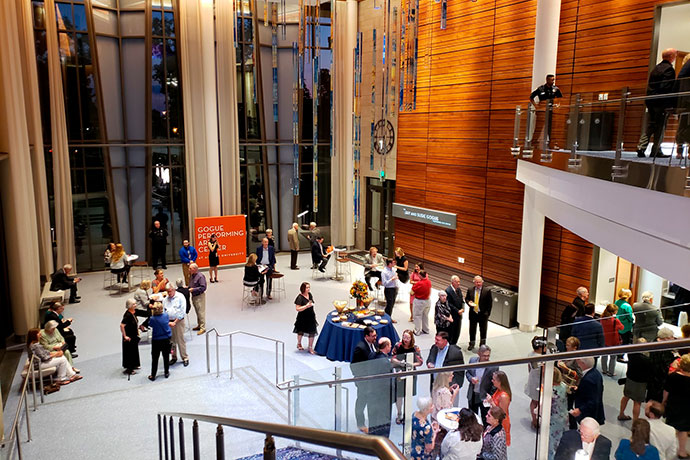A February 3 open house featuring visual and performing arts demonstrations, dancers, painters, and live music, provided the first glimpse inside Duke University’s 72,000-square-foot Rubenstein Arts Center. “The Ruby,” as it’s been affectionally dubbed, will be home to the university’s Dance Program and its Art of the Moving Image Program. The opening marks the culmination of Duke’s arts renaissance, which began in 2005 with the opening of the Nasher Museum of Art and continued with two recent auditorium renovations. The modernist glass facility establishes a highly visible focal point for the arts at Duke—but that’s just the beginning.
Theatre Projects, working with William Rawn Associates and Threshold Acoustics, designed a building that would open the arts to the entire campus and the community, create a showcase for students’ creativity, host artists from the surrounding area, and most importantly, facilitate interdisciplinary education.
The project team designed The Ruby to encourage artists to collaborate, converse, and learn from artists of other disciplines—as well as from non-arts students and the community at large. To achieve that goal, we worked with the university to imagine a facility that was extremely open, flexible, and robust. Immense glass-walled hallways, flexible sunlit multipurpose rooms, open planning, and oversized sliding doors and windows create a sense of openness that invites visitors to explore the space.
The primary performance space in the $40 million building, the von der Heyden Studio Theatre, features a flat floor, tension wire grid, 360-degree balcony, and technical ledge. It features double-height glass windows equipped with blackout shades and a pair of oversized sliding doors that open to the lobby, filling the room with sunlight and giving passersby an opportunity to see inside—inviting interdisciplinary collaboration.
The room can be arranged in traverse, flat floor, arena, thrust, or endstage configurations and features a retractable riser system that holds 108 seats. Another 40 seats on specially-designed movable platforms can be set up to create the different staging layouts. With loose seating on the mezzanine level, the theatre’s maximum seat count can reach 200.
We designed the studio theatre to create boundless creative opportunities. A tension wire grid runs across most of the room, giving students safe access to hang equipment and scenery. A series of balcony railing sections can be removed for additional staging and scenic options. The theatre’s performance lighting is a hybrid system of incandescent and LED fixtures, which gives students familiarity with both systems and leaves Duke room to expand to 100% LEDs in the future.
“The Rubenstein Center isn’t just a beautiful building,” Aaron Wong, assistant theatre designer, said. “It also gives Duke’s arts programs great potential to grow. We designed the theatre and studio spaces to make sure that they had the right infrastructure—cable passes, hybrid lighting systems, flexible seating, versatile studios—so they could rehearse, perform, and learn without worrying about expanding beyond their means.”
The most prominent feature of The Ruby, the main dance studio, is a voluminous glass cube with floor-to-ceiling windows that sits at the center of the building and juts out, overlooking the campus below. The studio features a pipe grid, performance lighting, sprung floors, walk-along curtain tracks, and demountable dance barres. Even small details like a sprung floor in the second-floor hallway were considered to ensure The Ruby was an exceptionally robust and usable arts building.
With the opening to the Rubenstein Center, and the creative and educational freedom it affords, Duke launched its second MFA Dance program, which emphasizes interdisciplinary exploration of dance and other disciplines. “We never just accept dance as a disconnected art-form,” Michael Kliën, associate professor of dance, said, “but are actively looking for connections to other fields of knowledge.”
Not only is The Ruby a dynamic resource for the performing arts, it’s also an invaluable asset for aspiring film-makers. We designed a 100-seat cinema that features five built-in archival film format projectors including several historical projectors that were refurbished exclusively for new arts center.
With so many dancers, film-makers, musicians, and visual artists in one place, we programmed The Ruby with incredible versatility. Six large multipurpose studios are scattered throughout the building, providing blank canvases for all forms of artistic exploration. While all six studios can meet nearly any need of performing or visual artists, two of the studios are tailored toward dance—featuring barres, mirrors, floor-to-ceiling windows, and sprung floors—and two are tailored toward media production, with pipe grids, and added electrical, AV, and projection infrastructure. Other features in the six studios include oversized sliding doors, large windows with blackout curtains, pipe grids, performances lighting, built-in sound and projection systems, and sound absorbing walls.
Far more than just a venue for dance, drama, and filmmaking, The Ruby also features three seminar classrooms, visual arts studios, student lounges, and a “makerspace,” which is operated by Duke’s Innovation Co-lab and features 3D printers and laser cutters.
For more than a decade, Duke has been encouraging the hands-on, practical experience, that forms the core of interdisciplinary education. Combining creativity—in the visual arts, dance, drama, and elsewhere—with technical knowledge and training has shown extraordinary results in creating well-rounded and highly capable graduates who can better engage with teams to understand and tackle problems. With the collaborations that The Ruby will inspire, Duke students can look forward to promising futures, not just as artists, but as visionaries and creators.









